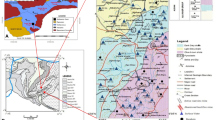Abstract
Acid precipitation may lead to loss of essential elements and increase the concentrations of potentially toxic elements in drinking water. In this study 46 private wells from acid regions(pH < 6.5) were compared with 43 private wells from alkaline areas in southern Sweden. The concentrations of about 30 elementswere analysed especially by inductively coupled plasma opticalemission spectroscopy (ICP-OES). The concentrations of essentialelements such as calcium, chromium, selenium and potassium weresignificantly lower in acid than in alkaline well water. On theother hand, the levels of potentially toxic metals such as cadmium and lead were significantly higher in acid well water. High copper concentrations, observed at pH around 6 in contrast to earlier findings, is to be considered as an acidification problem, as should the high fluoride values. The highest concentrations of a number of metals and ions, for example calcium, chromium, titanium and sulphate, appeared at pH 7.0–8.0, where the peak in concentrations occur due to leachingof metals from soil particles in acid soils and precipitation ofcarbonates and sulphates in more alkaline soils. The low levelsof especially calcium and magnesium ions, and some micronutrientsin the acid water, in combination with high concentrations of acid ions and toxic microelements, may cause nutritional imbalances. This should be regarded as risk factors with relationto effects on human health.
Similar content being viewed by others
References
Aastrup, M., Thunholm, B., Johnson, J., Bertills, U. and Berntell, A.: 1995, ‘The Chemistry of Ground Water. The Swedish Bed-rock’, SNV Report 4415.
Altman, D. G.: 1991, Practical Statistics for Medical Research, Chapman & Hall, London.
Avery, A. A.: 1999, ‘Infantile methemoglobinemia: Reexamining the role of drinking water nitrates’, Environ. Health Perspect. 107, 583–586.
Barkman, A., Warfving, P. and Sverdrup, H.: 1995, ‘Regionalization of critical loads under uncertainty’, Water, Air, and Soil Pollut. 85, 2515–2520.
Bensryd, I., Rylander, L., Högstedt, B., Aprea, P., Bratt, I., Fåhraéus, C., Holmén, A., Karlsson, A., Nilsson, A., Svensson, B.-L., SchÛtz, A., Thomassen, Y. and Skerfving, S., 1994, ‘Effect of acid precipitation on retention and excretion of elements in man, Elsevier’, Sci. Total Environ. 145, 81–102.
Bertills, U. and Hanneberg, P.: 1995, ‘Acidification in Sweden. What do we Know Today?’, NV, Report 4422, pp. 58–68.
Bodner, G. M. and Pardue, H. L.: 1995, Chemistry, an Experimental Science, John Wiley & Sons, Inc, New York, pp. 662–662.
Buchanan, S. D., Diseker III, R. A., Sinks, T., Olson, D. R., Daniel, J. and Flodman, T.: 1999, ‘Copper in drinking water, Nebraska, 1994’, Int. J. Occup. Environ. Health 5, 256–261.
Edwards, M., Chock, M. R. and Travis, E. M.: 1996, Alkalinity, pH and Copper. Corrosion Byproduct Release, Journal AWWA, pp. 81–94.
Eife, R., Weiss, M., Barros, V., Sigmund, B., Goriup, U., Komb, D., Wolf, W., Kittel, J., Schramel, P. and Reiter, K.: 1999, ‘Chronic poisoning by copper in tap water: I. Copper intoxications with predominantly gastrointestinal symptoms’, Eur. J. Med. Res. 28, 219–223.
EU: 1998, Council Directive 98/83/EC of the 3rd November 1998 on the Quality of Water Intended for Human Consumption.
Flaten, T. P.: 1991, A Nation-wide Survey of the Chemical Composition of Drinking Water in Norway, Elsevier Science Publishers B.V.
Frank, A., Galgan, V. and Petersson, L.: 1994, ‘Secondary copper deficiency, chromium deficiency and trace element imbalance in the moose (Alces alces L.). Effect on antropogenic activity’,Ambio 23(4-5), 315–317.
Frank, A.: 1998, ‘ ‘Mysterious’ Moose Disease in Sweden: Similarities to Copper Deficiency and/or Molybdenosis in Cattle and Sheep. Biochemical Background of Clinical Signs and Organ Lesions’, Science-of-the-Total Environment, 8 January, 209, 17–26.
Giordano, R. and Costantini, S.: 1993, ‘Some aspects related to the presence of aluminium in waters’, Ann. Ist. Super Sanita 29, 305–311.
Grimsdottir, M. R. and Hensten-Pettersen, A.: 1993, ‘Cytoxic and antibacterial effects of orthodontic appliances’, Scand. J. Dent. Res. 101, 229–231.
Gupta, S. K., Gupta, R. C., Seth, A. K., Gupta, A. B., Bassin, J. K. and Gupta, A.: 2000a, ‘Methaemoglobinaemia in areas with high nitrate concentration in drinking water’, Natl. Med. J. India 13, 58–61.
Gupta, S. K., Gupta, R. C., Gupta, A. B., Seth, A. K., Bassin, J. K. and Gupta, A.: 2000b, ‘Recurrent acute respiratory tract infections in areas with high nitrate concentrations in drinking water’, Environ. Health Perspect. 108, 363–366.
Halpern, G. M., Van de Water, J. and Delebroise A.-M.: 1991, ‘Comparative uptake of calcium from milk and a calcium-rich mineral water in lactose intolerant adults: Implications for treatment of osteoporosis’, Am. J. Prev. Med. 7(6), 379–383.
Holmström, H. and Swedling, E.-O.: 1997, Vatten (Water) 53, 191–196.
Hägg, E., Carlberg, B. C., Hillörn, V. S. and Villumsen, J.: 1999, ‘Magnesium therapy in type 1 diabetes. A double blind study concerning the effects on kidney function and serum lipid levels’, Magnes. Res. 12, 123–130.
Hägg, G.: 1969, General and Inorganic Chemistry, Almqvist and Wiksell, Stockholm, pp. 335–338.
Iso, H., Stampfer, M. J., Manson, J. E., Rexrode, K., Hennekens, C. H., Colditz, G. A., Speizer, F. E. and Willett, W. C.: 1999, ‘Prospective study of calcium, potassium, and magnesium intake and risk of stroke in women’, Stroke 30, 1772–17779.
Johansson, K., Bringmark, E., Lindevall, L. and Wilander A.: 1995, ‘Effects of acidification on the concentrations of heavy metals in running waters in Sweden’, Water, Air, and Soil Pollut. 85, 779–784.
Knobeloch, L., Ziarnik, M., Howard, J., Theis, B., Farmer, D., Anderson, H. and Proctor, M.: 1994, ‘Gastrointestinal upsets associated with ingestion of copper-contaminated water’, Environ. Health Perspect. 102, 958–961.
Knobeloch, L., Salna, B., Hogan, A., Postle, J. and Anderson, H.: 2000, ‘Blue babies and nitratecontaminated well water’, Environ. Health Perspect. 108, 675–678.
Korshin, G. V., Perry, S. A. L. and Ferguson, J. F.: 1996, Influence of NOM on Copper Corrosion, Journal AWWA, July, pp. 36-46.
Morrier, J. J., Suchett-Kaye, G., Nguyen, D., Rocca, J. P., Blanc-Benon, J. and Barsotti, O.: 1998, ‘Antimicrobial activity of amalgams, alloys and their elements and phases’, Dent. Mater. 14, 150–157.
Mushak, P.: 1985, ‘Potential impact of acid precipitation on arsenic and selenium’, Environ. Health Perspect. 63, 105–113.
Merza, M., Larsson, E., Steen, M. and Morein, B.: 1994, ‘Association of a retrovirus with a wasring condition in the swedish moose’, Virology 202, 956–961.
Nihlgård, B.: 1997, ‘Forest Decline and Environmental Stress’, in D. Chapman (ed.), The Global Environment, VCH, pp. 422–440.
Nordberg, G. F., Goyer, R. A. and Clarkson, T. W.: 1985, ‘Impact of effects of acid precipitation on toxicity of metals’, Environ. Health Perspect. 63, 169–180.
The National Swedish Food Administration (NSFA FS): 1997, 32, pp. 58–70.
Dietary Reference Intake (DRI): 1998, National Academy Press, Washington DC.
Pizarro, F., Olivares, M., Uauy, R., Contreras, P., Rebelo, A. and Gidi, V.:1999, ‘Acute gastrointestinal effects of graded levels of copper in drinking water’, Environ. Health Perspect. 107, 117–121.
Rylander, R.: 1996, ‘Environmental magnesium deficiency as a cardiovascular risk factor’, J. Cardiovasc. Risk 3, 4–10.
Scheck, H. J. and Pscheidt, J. W.: 1998, ‘Effect of copper bactericides on copper-resistant and-sensitive strains of pseudomonas syringae pv. syringae’, Plant Dis. 82, 397–406.
Spitalny, K. C., Brondum, J., Vogt, R. L., Sargent, H. E. and Kappel, S.: 1984, ‘Drinking-waterinduced copper intoxication in a Vermont family’, Pediatrics 74, 1103–1106.
Stenhammar, L.: 1999, ‘Diarrhoea following contamination of drinking water with copper’, Eur. J. Med. Res. 28, 217–218.
Van Loon, G. W. and Duffy S. J.: 2000, Environmental Chemistry, A Global Perspective, Oxford University Press, pp. 90-100.
WHO (World Health Organisation): 1993, Guidelines for Drinking-water Quality, 2nd ed., Vol. 1, pp. 39–57.
WHO (World Health Organisation): 1996, Trace Elements in Human Nutrition and Health, pp. 49- 229, 273.
Author information
Authors and Affiliations
Corresponding author
Rights and permissions
About this article
Cite this article
Rosborg, I., Nihlgård, B. & Gerhardsson, L. Inorganic Constituents of Well Water in One Acid and One Alkaline Area of South Sweden. Water, Air, & Soil Pollution 142, 261–277 (2003). https://doi.org/10.1023/A:1022078925064
Issue Date:
DOI: https://doi.org/10.1023/A:1022078925064




